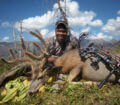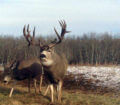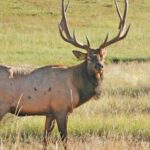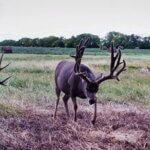Editor’s Note: Longtime, avid hunter Marshall Johnson of Bismarck, North Dakota, is the senior regional director for the Mule Deer Foundation https://muledeer.org/ that restores, improves and protects mule deer habitat, including land and easement acquisitions, and develops programs that help mule deer and black-tailed deer conservation. Mule deer and black-tailed deer live throughout western North America from the coastal islands of Alaska down the West Coast to southern Baja, Mexico, and from the northern border of the Mexican state of Zacatecas, up through the Great Plains to the Canadian provinces of Saskatchewan, Alberta, British Columbia and the southern Yukon Territory. Mule deer: are browsers with a majority of their diet weeds and leaves and twigs of woody shrubs; grow 3 to 3-1/2 feet tall and generally weigh 130-280 pounds; have a 310-degree view around themselves due to their eyes being located on the sides of their heads; can detect movement up to 1900+ feet away; and have a sense of smell 1,000 times stronger than a human’s.
 In the past couple of years, we’ve seen improvements in America’s mule deer herd. All across the mule-deer range are pockets where the mule deer are doing fairly well, and also there will be pockets where the mule deer aren’t doing so well. The reason for this is that weather is the number-one culprit impacting mule-deer populations. Especially in the Northwest, weather is the number-one killer of mule deer and other wildlife. If you look at a typical year with good summers, and the mule deer have fed up and have a good layer of fat on them, you would think they could sustain heavy snowfalls. However, when you add in the rut, many of those mule-deer bucks get beat-up badly, fighting one another. But those bucks usually live until March, although they may be in a bad condition. If we get a really-tough blizzard in later March, that seems to be when the most mule-deer fatalities occur.
In the past couple of years, we’ve seen improvements in America’s mule deer herd. All across the mule-deer range are pockets where the mule deer are doing fairly well, and also there will be pockets where the mule deer aren’t doing so well. The reason for this is that weather is the number-one culprit impacting mule-deer populations. Especially in the Northwest, weather is the number-one killer of mule deer and other wildlife. If you look at a typical year with good summers, and the mule deer have fed up and have a good layer of fat on them, you would think they could sustain heavy snowfalls. However, when you add in the rut, many of those mule-deer bucks get beat-up badly, fighting one another. But those bucks usually live until March, although they may be in a bad condition. If we get a really-tough blizzard in later March, that seems to be when the most mule-deer fatalities occur.
 Many people believe that heavy winter snows cause the most mule-deer fatalities. However, the late March/winter snows have the most-devastating effects on most of the mule-deer herds in the West. In North Dakota and eastern Montana in 2010 – 2012, we had three horrific winter snows, and those states lost about 75% of their mule-deer herds during that time. Those winters went from November and deep in March. Fortunately, states like North Dakota’s Game and Fish Department did excellent jobs of managing their mule-deer herds and helping the herds to rebuild by limiting the number of tags that were given out to bring the number of mule deer in the herds back up. I went to quite a few meetings that our Department of Game and Fish had with hunters and heard numbers of hunters say, “Let us put our guns away for a few years, if that will help the population of mule deer get back to where it needs to be. We still can hunt pheasants, grouse and geese.”
Many people believe that heavy winter snows cause the most mule-deer fatalities. However, the late March/winter snows have the most-devastating effects on most of the mule-deer herds in the West. In North Dakota and eastern Montana in 2010 – 2012, we had three horrific winter snows, and those states lost about 75% of their mule-deer herds during that time. Those winters went from November and deep in March. Fortunately, states like North Dakota’s Game and Fish Department did excellent jobs of managing their mule-deer herds and helping the herds to rebuild by limiting the number of tags that were given out to bring the number of mule deer in the herds back up. I went to quite a few meetings that our Department of Game and Fish had with hunters and heard numbers of hunters say, “Let us put our guns away for a few years, if that will help the population of mule deer get back to where it needs to be. We still can hunt pheasants, grouse and geese.”
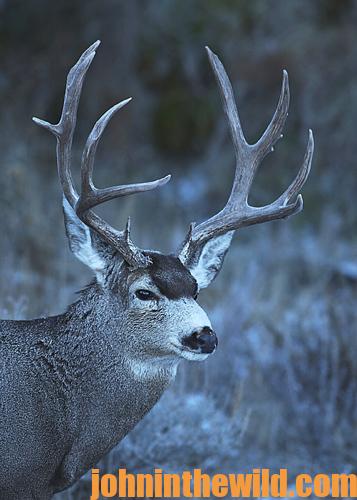 In North Dakota and South Dakota, we’re seeing about a 25% increase in the number of tags being allotted for harvesting mule deer. There are pockets where the mule-deer population is still struggling, for instance in central and eastern Washington. Those places were hit very hard by wildfires three years ago, but those herds are starting to rebuild. However, overall throughout the mule-deer range, I feel we’ve had a good year of mule-deer reproduction, due to adequate rain.
In North Dakota and South Dakota, we’re seeing about a 25% increase in the number of tags being allotted for harvesting mule deer. There are pockets where the mule-deer population is still struggling, for instance in central and eastern Washington. Those places were hit very hard by wildfires three years ago, but those herds are starting to rebuild. However, overall throughout the mule-deer range, I feel we’ve had a good year of mule-deer reproduction, due to adequate rain.
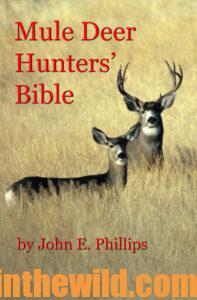 To learn more about hunting mule deer, go to John E. Phillips’ book, “Mule Deer Hunters’ Bible,” available in Kindle and print versions and including information from 30+ mule deer hunters, at https://www.amazon.com/dp/B07QHCLFYB.
To learn more about hunting mule deer, go to John E. Phillips’ book, “Mule Deer Hunters’ Bible,” available in Kindle and print versions and including information from 30+ mule deer hunters, at https://www.amazon.com/dp/B07QHCLFYB.

